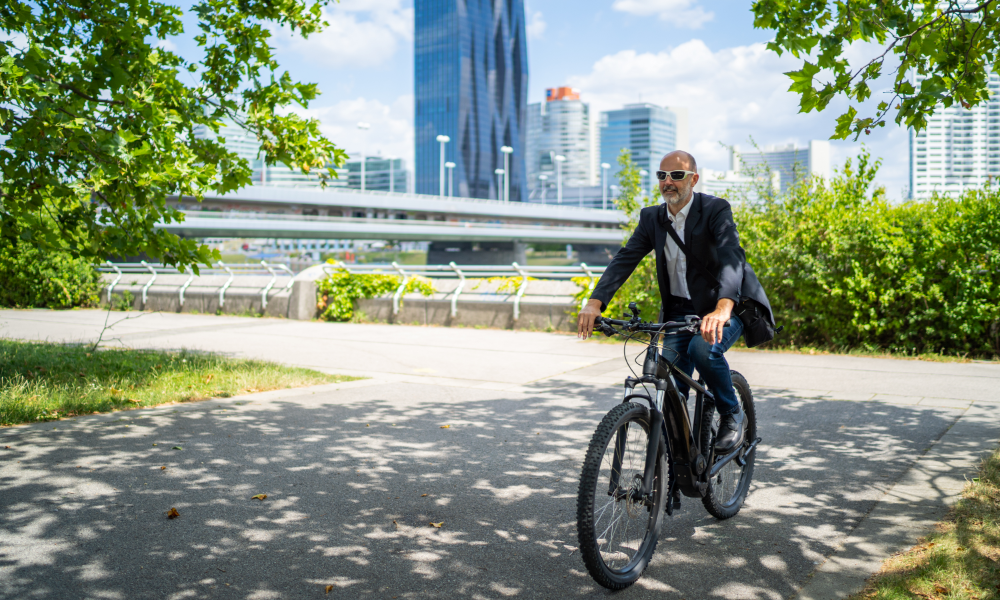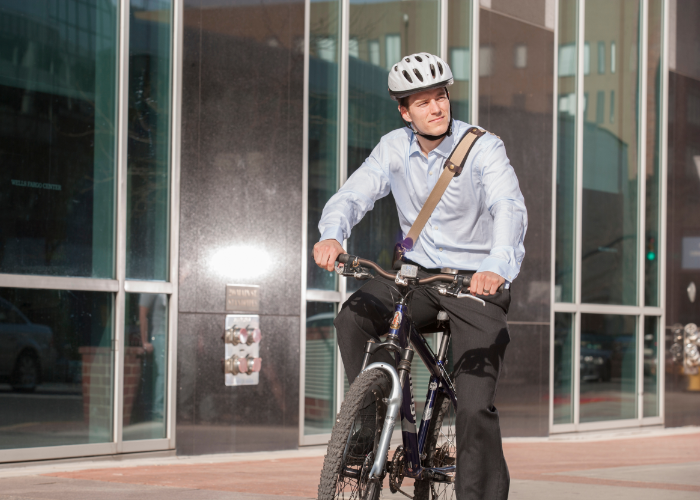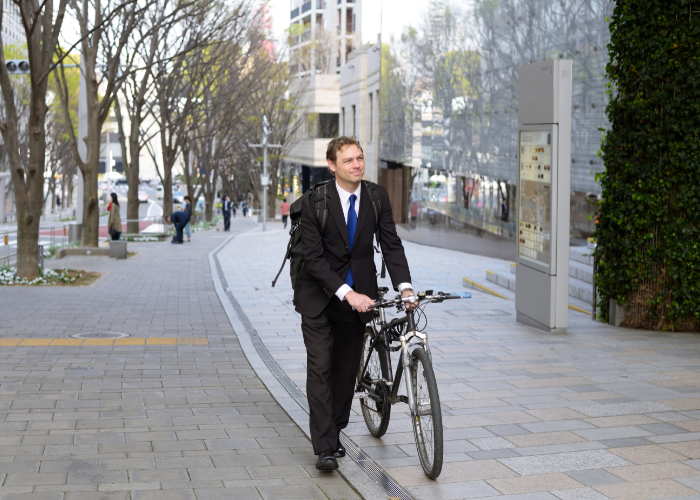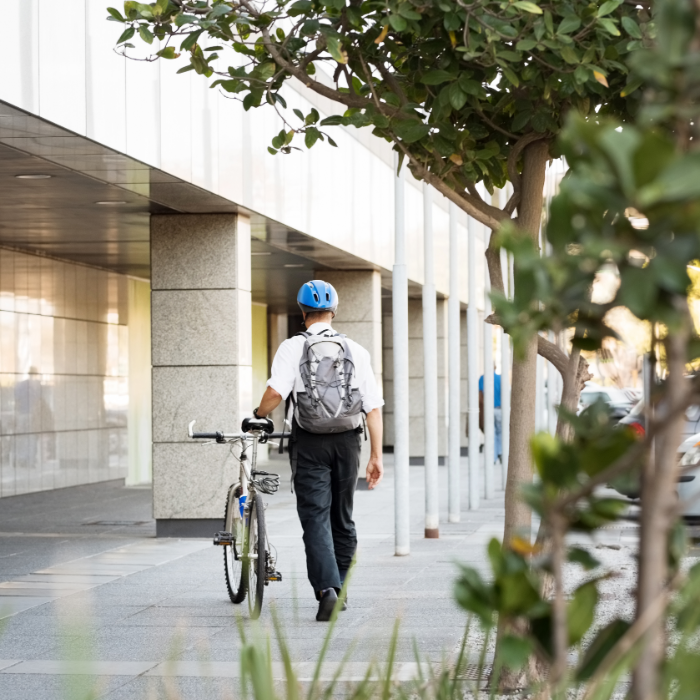Mountain bikes are versatile, rugged machines designed to tackle off-road terrain – but can they make for a reliable and comfortable commuter bike? In this post, we’ll explore the pros and cons of using a mountain bike for your daily commute and offer tips on how to adapt your off-road warrior for the urban jungle.
Whether you’re looking to save money on transportation, improve your fitness, or simply enjoy the fresh air, opting for a mountain bike might just be the ticket. Let’s dive into the benefits and drawbacks of bike commuting on a mountain bike and help you decide if it’s the right choice for you.
Are mountain bikes good for commuting? Let’s find out…
Pros and Cons of Commuting on a Mountain Bike
Mountain bikes have certain advantages over other bike types, such as road bikes, when it comes to commuting. Their comfortable, upright riding position, better grip on bumpy surfaces, and sturdy frame make them a good alternative to a typical commuter bike.
However, using a mountain bike, such as a downhill bike, for commuting also has its downsides, including slower speeds and less efficiency on smooth roads, and potentially more maintenance.
Considering these pros and cons can help you decide if a mountain bike is the right choice for your commute. The following sections will examine the various aspects that contribute to or hinder the suitability of mountain bikes for commuting.
Advantages
- One of the main advantages of a mountain bike is its comfortable, upright riding position. This can be particularly beneficial for those who experience back pain, as it reduces strain on the spine compared to the more aggressive, leaned-forward position of road bikes.
- Additionally, mountain bikes are designed with wider, knobby tires and often feature front suspension, providing better traction and control on rough surfaces and dirt trails.
- Furthermore, mountain bikes are known for their durability. Their strong frames can withstand the wear and tear of daily commutes on rough roads and changing weather conditions, making them a reliable option for those looking for a versatile ride.
Disadvantages
While mountain bikes offer many benefits, they also come with some drawbacks when used for commuting. Here are a few:
- They’re generally slower and less efficient on smooth roads than road bikes.
- Their wide, knobby tires create more rolling resistance, making it harder to pedal efficiently and increasing the likelihood of arriving at your destination sweaty and exhausted.
- The extra weight of a mountain bike can make it more cumbersome to maneuver in traffic and carry up and down stairs.
- Another disadvantage is the suspension system found on most mountain bikes. While it provides a smoother ride on rough terrain, it can decrease pedaling efficiency on paved roads. Suspension bob, the vertical motion created when pedaling, can lead to reduced power transfer and increased fatigue on longer commutes.
Mountain Bikes and Commuting: A Closer Look
The suitability of a mountain bike for commuting largely depends on the specific conditions of your daily ride. Mountain bikes shine on rough roads, off-road patches, and varied weather conditions, lending versatility for commuters facing such challenges. But, their slower speeds and less efficient design may not make them the ideal choice for longer journeys or predominantly smooth, paved roads.
In the end, whether a mountain bike is apt for commuting hinges on the roads you traverse and your present fitness level. If you have to ride on bumpy roads or off-road, then a mountain bike might be a good option for you. If your fitness level is up to it, then commuting on a mountain bike could be effective.
Riding Comfort and Position
As mentioned earlier, mountain bikes offer a comfortable, upright riding position. This can be particularly beneficial for those who experience back pain, as it reduces strain on the spine compared to the more aggressive, leaned-forward position of road bikes.
However, the upright position also limits your pedaling power and aerodynamics compared to road bikes, making them a less efficient option for some commuters.
To strike a balance between comfort and efficiency, you can explore different bike types, such as hybrid bikes, which combine the comfortable, upright position of mountain bikes with the lighter weight and more efficient design of road bikes.
Traction and Control
Mountain bikes are known for their excellent traction and control on rough surfaces and in poor weather conditions. Their wide, knobby tires provide better grip on steep and loose climbs, enabling you to stay in control even on challenging terrain. Additionally, the suspension system helps absorb shocks and bumps, further improving traction and control on rough surfaces.
This makes mountain bikes a safer option for those who have to navigate rough roads, off-road sections, or inclement weather on their daily commute. However, if your route is predominantly smooth and paved, a road bike or hybrid bike with slicker tires may provide a more efficient and comfortable ride.
Durability and Versatility
Mountain bikes, ridden to withstand the rigors of off-road use, are highly durable and versatile machines. Their strong frames can handle a variety of terrains, from dirt roads to rocky trails, and they often come equipped with mounts for racks and fenders, allowing you to carry gear and work essentials with ease.
However, mountain bikes tend to be heavier and less efficient than other bike types, making them less suitable for longer commutes on smooth roads.
For those who need a bike that can handle both their daily commute and weekend off-road adventures, a mountain bike may be the ideal choice. Otherwise, consider other bike types like road or hybrid bikes that may offer a more efficient and comfortable ride on paved roads.
Adapting Your Mountain Bike for Commuting
If a mountain bike is your choice for daily commuting, certain modifications can assure a smoother, more efficient ride. These include selecting appropriate tires, adding accessory mounts, and adjusting the suspension for a smoother ride on paved roads.
These adaptations can morph your off-road machine into a reliable, comfortable commuter bike still capable of weekend adventures on rough terrain. Here’s a deeper dive into each of these modifications.
Tire Selection
Selecting appropriate tires for your commute is key to a smooth, efficient ride. Here are some options to consider:
- Mountain bike tires: These are designed to provide better traction on rough surfaces, but their wide, knobby design creates increased rolling resistance on smooth roads.
- Narrow, slick tires: Switching to narrower, slick tires can improve efficiency and maintain a comfortable ride on paved roads.
- Semi-slick tires: These tires have a combination of smooth and knobby tread, offering a balance between traction and efficiency.
When selecting tires, consider factors like the type of terrain, weather, and road conditions you’ll encounter on your commute. This will help you find the best balance between grip, comfort, and efficiency for your specific route.
Accessory Mounts
Equipping your mountain bike with accessory mounts can enhance its suitability for commuting. Mountain bikes often lack the mounting eyelets found on other bike types, so you’ll need to find alternative ways to attach essential accessories like racks, fenders, and lights. Some options include seat post-mounted racks, clip-on fenders, and handlebar-mounted lights.
When selecting accessory mounts, ensure they are compatible with your mountain bike’s frame and suspension system. This will help you avoid any installation issues or potential damage to your bike’s components.
Suspension Adjustments
Tweaking your mountain bike’s suspension can enhance efficiency and comfort on paved roads during your commute. Most mountain bikes come with front suspension, which provides a smoother ride on rough terrain but can decrease pedaling efficiency on smooth roads due to suspension bob. To counteract this, you can adjust the suspension settings, such as the lockout lever, compression damping, and sag, to optimize your bike’s performance on paved roads.
Such adjustments can help strike a balance between comfort and efficiency, guaranteeing a smooth, reliable commute on your mountain bike.
Choosing the Right Bike for Your Commute
To choose the right bike for your commute, you’ll need to carefully assess your route and compare different bike types. Factors to consider include:
- Distance
- Terrain
- Road conditions
- Personal preferences
By taking all these factors into account, you can make an informed decision on whether a mountain bike is the best choice for your daily ride.
The subsequent sections offer guidance on evaluating your route and comparing various bike types to find your best commuting fit.
Assessing Your Route
To ascertain if a mountain bike is the ideal choice for your commute, begin by assessing the road conditions of your route. Consider factors like the type of terrain, the amount of traffic, and any potential obstacles you may encounter.
Next, look at the off-road sections of your route, if any, and think about the kind of terrain, the amount of traffic, and any obstacles you might face.
Finally, take into account the weather conditions, such as temperature, precipitation, and wind speed, as these can impact your ride and the type of bike that is best suited for your needs. By considering these factors, you can determine if a mountain bike is the best choice for your commute or if another bike type, like a road bike or hybrid bike, might be more suitable.
Comparing Bike Types
In selecting the optimal bike for your commute, comparing different bike types, like mountain bikes, road bikes, hybrid bikes, and city bikes is crucial. Each type has its own set of advantages and disadvantages, depending on factors like distance, terrain, and personal preferences.
Mountain bikes, as mentioned earlier, excel on rough terrain and in varying weather conditions, making them a versatile option for those who encounter such challenges on their commute. However, they may not be the best choice for longer commutes or those predominantly on smooth roads due to their slower speeds and less efficient design. A cross country mountain bike, for instance, would be more suitable for off-road adventures rather than daily commutes.
To find the best fit for your commute, consider trying out different bike types at your local bike shop and taking them for test rides on your daily route.
Tips for a Successful Mountain Bike Commute
Once you’ve decided on the right bike for your commute, follow some practical tips to ensure a smooth and enjoyable ride. These include regular maintenance and cleaning, riding safely in traffic, and carrying your gear and work essentials in a comfortable and organized manner.
The subsequent sections will offer specific tips on maintaining your mountain bike, ensuring safe riding in traffic, and comfortably transporting your gear and work essentials.
Maintenance and Cleaning
Keeping your mountain bike in prime condition for a reliable, smooth commute requires regular maintenance and cleaning. Check the brakes, tires, and chain regularly to ensure they are functioning properly and replace any worn-out parts as needed.
After each ride, give your bike a thorough clean to remove any dirt, grime, and debris that can accumulate during your commute. By taking care of your mountain bike and keeping it well-maintained, you can ensure a smooth and enjoyable commute while also prolonging the life of your bike.
Riding Safely in Traffic
Safe riding habits in traffic are vital when commuting on a mountain bike. This includes:
- Signaling your turns
- Wearing a helmet
- Using lights and reflective gear to increase your visibility to other road users
- Being mindful of your surroundings
- Sticking to traffic laws
- Riding defensively to avoid potential hazards and accidents.
By following these safety tips, you can confidently navigate through traffic on your mountain bike and enjoy a worry-free commute.
Carrying Gear and Work Essentials
For a comfortable commute with your gear and work essentials, consider adopting storage solutions designed for bike commuting, such as panniers or backpacks. Choose a storage option that best suits your needs, taking into account the size and weight of the items you need to carry, as well as the type of terrain you’ll be riding on.
By selecting the right storage solution, such as a rear rack, you can ensure that your gear and work essentials are organized and easily accessible throughout your commute, making your daily ride more enjoyable and efficient.
Summary
In conclusion, mountain bikes can be a viable option for commuting, offering a comfortable, upright riding position, better traction on rough surfaces, and a durable frame. However, they may be slower and less efficient on smooth roads and may require more maintenance than other bike types. By assessing your commute route, comparing different bike types, and considering factors like distance, terrain, and personal preferences, you can make an informed decision on whether a mountain bike is the right choice for your daily ride.
With the right modifications and maintenance, a mountain bike can provide a reliable and enjoyable commute, while also being versatile enough to tackle weekend off-road adventures. Happy riding!
Frequently Asked Questions
Is a mountain bike good for everyday use?
A mountain bike can make a great everyday ride, depending on the type and intended use. It’s best to look at each individual type of bike and assess its suitability for riding on roads. Mountain bikes come in a variety of styles, from hardtail to full suspension. Hardtail bikes are designed for cross-country riding, while full suspension bikes are better suited
What are the disadvantages of mountain bikes?
Mountain bikes have higher rolling resistance and less aerodynamic design, making them unsuitable for long-distance rides. They also have a more relaxed geometry which makes them slower on paved roads and they are heavier than other bike types.
What is the ideal distance for a bike commute?
For a comfortable bike commute, aim for a distance of less than 10km.
Can I put narrower tires on my mountain bike for city riding?
Yes, you can put narrower tires on your mountain bike for city riding, but check with a bike shop first to ensure brake mountain, frame/fork clearance and bottom bracket height won’t be affected. This is important to make sure that your bike is safe and comfortable to ride.
What are some tips for maintaining my mountain bike for commuting?
Maintain your mountain bike for commuting by checking the brakes, tires, and chain regularly, and give it a thorough clean after each ride.




